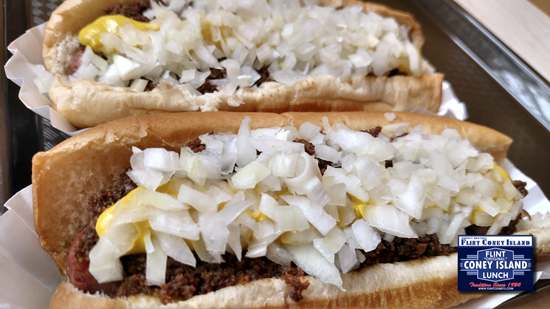
Related:
If you know someone from the Midwest and you offer them a chili dog somewhere, you might hear a response similar to “Well it’s not a coney, but alright.” If you’re the person from the Midwest in that conversation, you’ll know there’s nothing that can replace the coney you know and love. It has to have the “snap” of the natural lamb or sheep casing on a properly-grilled German “coney dog”, which is a variation of the European-style Frankfurter Würstel or Vienna sausage. The coney has to be topped with a flavorful meat topping having the memorable flavor of ground beef heart and maybe ground beef along with some other organ meats (depending on your style and/or restaurant of choice), cumin, and paprika. And purists always have that meat topping garnished with a couple lines of good yellow mustard, and onions minced to be silky smooth.
If you’re the kind of person who gets deeper into this sort of thing, you’ll know there are three basic coney varieties in Michigan: The dry-sauced Jackson Coney, developed by George Todoroff in about 1914; The juicier-sauced Detroit Coney, developed by someone at either of the side-by-side American or Lafayette Coney Islands (there are too many versions of the story to sort out) in about 1917; And of course the Flint Coney, with the Flint Coney Island restaurant opening south of the Flint River at 202 S. Saginaw St. in 1925. (the year it first showed up in R.L. Polk & Co.’s Flint City Directory was 1926.)
In early January 2021 after an online comment claimed Lafayette Coney Island in Detroit had stopped using beef heart in the 1960s, I emailed the store and asked. The answer was that they do not use beef heart there. As I know they still use beef heart in the sauce next door at American Coney Island, sauce made by Detroit Chili Co., Inc., the differences in the two sauces is clear.
Flint Original Coney Island founder Simion P. Brayan had immigrated from Boufi, Macedonia, in 1916, ending up in Flint after 1921 after spending a few years as a fur dryer in Toronto. It was the savory tastes of Macedonia that accounts for the flavors and textures of the Flint Coney.
It’s been reported that Brayan visited a lunch counter in Rochester, New York. He reportedly ordered what they called a “Coney Island,” then was quoted as saying it was “practically tasteless…unfit for a young man whose palate was accustomed to the hardy cuisine of southeast Europe.…They used ground beef, a little chili powder, a little paprika, but it had no taste.” Thinking back to a Macedonian goulash he’d eaten back in his hometown of Boufi, which contained beef heart and occasionally beef kidney, all in a beef suet base, he determined he could make a better coney sauce based on the heartiness of that Macedonian dish.
It was Brayan who got together with Edward Abbott and Albert Koegel sometime between 1921 and 1925 to respectively create what was needed for the Flint Coney’s sauce base and Coney Franks.
One thing I’m doing my best to correct, is peoples’ perception of what a Flint Coney really is. So before we go any further, let’s get something straight:
There is no such thing as a single restaurant recipe for Flint Coney sauce.
Making Flint Coney sauce at restaurants is relatively simple, using the 25 lb bag of ground beef hearts pictured above. A fat is melted, originally beef tallow or suet but now more likely lard, shortening, or vegetable oil, and minced onions are sautéed in the hot fat. When the onions are translucent, the restaurant’s own combination of spices is added. Those spices include good amounts of cumin, paprika, and hot chili powder, generally about eight ounces each. Once the spices are blended into the onion and fat mixture, the 25 lbs of raw extra fine grind of “beef, beef heart and soy texture” from Abbott’s Meat is added, along with any other ground meat components the restaurant might use, such as beef kidney or liver. The sauce is then allowed to simmer for more than an hour to tenderize the ground beef heart to the right consistency. The sauce can then be held over low heat all day for service.
In examining the conjecture surrounding the folklore-ridden recipe containing ground hot dogs, and in considering that some restaurants may have added, or still may be adding, chopped hot dogs to be frugal and not wasteful according to their Macedonian culture, a few facts emerge:
- The restaurants wouldn’t have ground fresh Koegel Coney Franks into their sauce, but instead would have used grilled Coneys leftover from the previous day. Grilling changes both the flavor and the texture, creating a more savory dish.
- As Abbott’s provided their Coney Topping Base to individual restaurants beginning in 1925, and as their menus were quite small, those restaurants likely wouldn’t have had a meat grinder among their equipment. They may have done the chopping with a couple of bench scrapers on a cutting board or the flattop.
- The additional unseasoned but grill hot dog meat would be cause to increase the amount of spices used in the sauce.
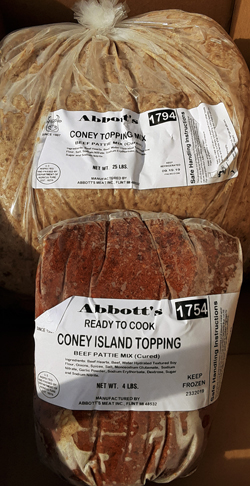
Abbott’s Coney Topping Mix; Beef Pattie Mix (Cured), 25 lbs – Ingredients: Beef Hearts, Beef, Water Hydrated Textured Soy Flour, Salt, Sodium Nitrate, Sodium Erythorbate, Dextrose, Sugar and Sodium Nitrite
Abbott’s Ready To Cook Coney Island Topping; Beef Pattie Mix (Cured), 4 or 10 lbs – Ingredients: Beef Hearts, Beef, Water Hydrated Textured Soy Flour, Onions, Spices, Salt, Monosodium Glutamate, Sodium Nitrate, Garlic Powder, Sodium Erythorbate, Dextrose, Sugar and Sodium Nitrite
The ready-to-cook Coney Island Topping is also raw. However, it only needs to be thawed and simmered to an internal temperature of 165°F before serving. Nothing else needs to be added.

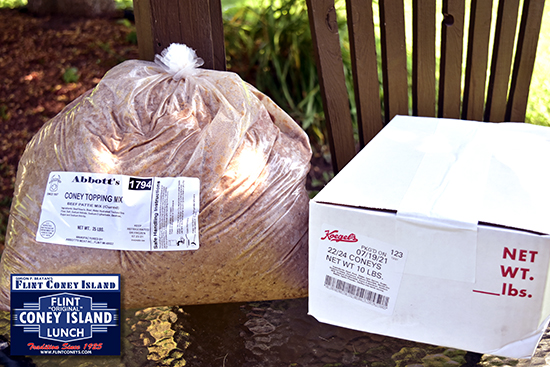
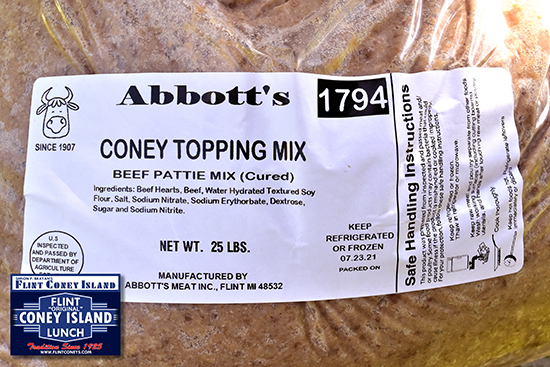
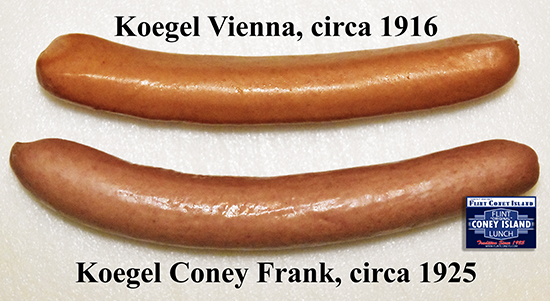
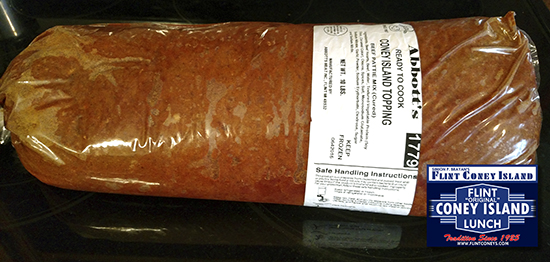
Where can you buy the packages of 4# and 25# and what is the cost? Can it be mailed to me?
Hi Carole … Abbott’s Original Coney Island Topping is available for home purchase from Lynch Shipping, in partnership with Koegel Meats, in a 4 lb bag at buykoegels.com. A 10 lb bag is also available on their site by clicking here. The 25 lb bag is only the ground beef heart and filler, which is shipped to restaurants for their use. I’m not sure at this point if Abbott’s offers this bag in their retail shop at their plant or not.
Thanks for an interesting story from your area. All the states have a good hot dog story and theirs are always the best, its truly what you grew up with, here in Oklahoma in OKC its the Original Coney Island since 1924 in El Reno its the coneys with the mustard slaw (delish) since the twenties also also the fried onion burgers. thanks again and have a great dog today.
Hi Truman, and thank you for the info! I tracked down the place you mentioned, then modified your comment just enough to add a link to their Facebook page since they have no web site. It looks really good there, if we’re ever in the area I’ll have to seek them out. I’ll add your info to other pages here where I discuss other styles and locations. Thanks again!
Dave
Working on a television segment about the non-Detroit coneys in Michigan. Would like to talk with you. I did something about the Detroit ones a few years ago…
If you are researching, please include Coney Island in Kalamazoo. Opened in 1915 by Greek immigrants and still owed n operated by the same family in the same location downtown. It is a real coney…not a Detroit style. I’ve had all of them including Flint and Jackson, and Kalamazoo is my favorite. Apparently there is some debate of which came first…Jackson says 1914, Kalamazoo is 1915. I’m curious if there is any relationship between the two founders. The style is similar yet distinctly different.
My Dad dated the woman who became is wife dated at the Flint Oriinal on Saginaw Street. Late 50’s to early ’60s, my families Christmas Eve tradition was to pick up copies at Flint Original for our supper before attending church.
Thanks for this very interesting history. My Dad served in army in WWII and said he had been to NY before shipping to Europe & Flint Original was the best coney. I always believed him & still do. Detroit is too soupy, I have to admit never tried Kalamazoo or Jacksons but can’t imagine they’re better!!!!